Damage due to friction and wear can causes economic losses to your Company. This is why Tribology Knowledge is important. Our Company performs extensive research on these topics and is able to provide you suitable lubricants for your needs to avoid losses and take care of your assets.
Friction is the resistance force to the relative motion of two surfaces. In a technical system, friction can cause energy loss, heat and wear and for this reason the aim is to reduce it.
Some types of friction are sliding friction, pivoting friction, rolling friction and rolling resistance friction.
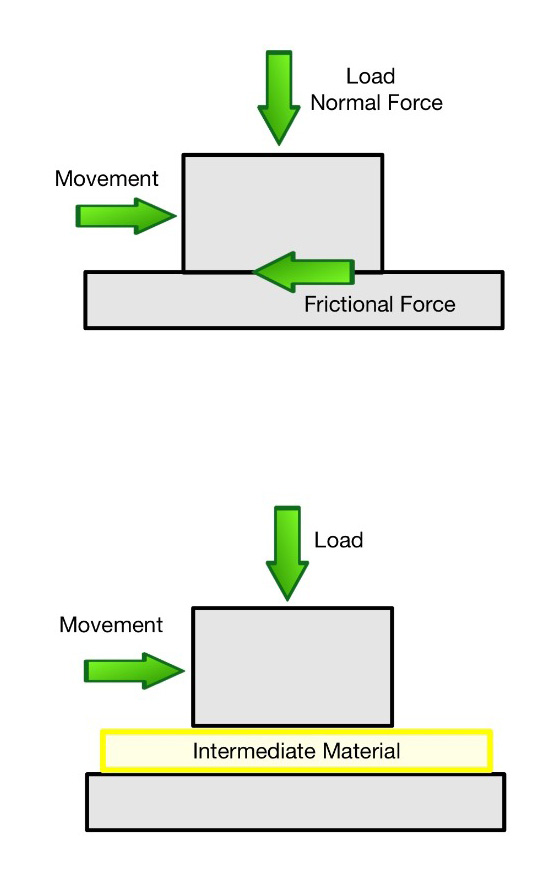
A coefficient of friction (μ) can be determined dividing the Frictional Force (FR) by the Normal Force (FN).

A tribological system is full of complex interactions. An intermediate material, in this case a lubricant, can be selected considering the ambiental influences (dust, temperature, moisture), the structural factors (materials and their surface and geometry), and stress factors (speed, vibrations or pressure).
Our company has the knowledge to consider all these factors to recommend the most suitable lubricant for your process.
The Stribeck curve shows the friction variation of a friction bearing with oil or grease lubrication in the entire range of lubrication, including hydrodynamic, mixed and boundary lubrication regimes. The start-up phase is followed by the solid state friction. As speed increases the sliding surfaces start to separate (mixed friction phase). At higher speeds (hydrodynamic phase), a liquid film completely separates the sliding surfaces. At this point, low wear and low friction are achieved.
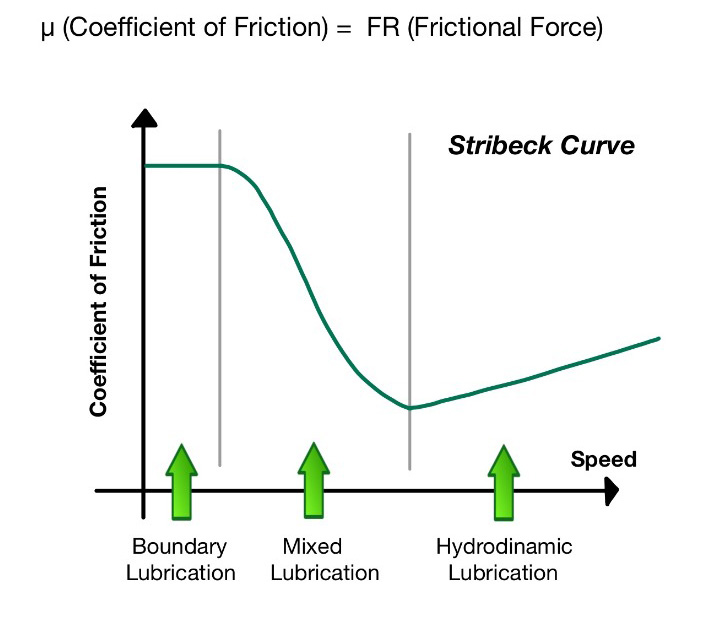
Not only lubrication is the main function of lubricants. Lubricants are responsible for many other functions, including separating, sealing, cooling and protecting. Our products are oriented to provide maximum power transfer with minimum friction and wear, but they are also capable to fulfill other needs such as water and chemical resistance, corrosion protection, and compatibility with plastics.

Oil lubrication is suitable for high temperatures or high rotation speeds. They are good for heat dissipation, and they have good creep and wetting behaviour.
Oil lubrication is recommended for gears, chains, friction bearings, hydraulics and compressors.
The characteristics and standards that need to be considered to choose an oil are:
Characteristics |
Standard |
Definition |
Viscosity |
DIN 51562-1 |
The dimension of internal friction. |
ISO VG |
DIN 51519 |
Oil viscosity classification. |
Operating Temperature |
|
Range for optimal function. |
Flash Point |
DIN ISO 2592 |
Lowest temperature at which its vapors ignite through extraneous ignition. |
Setting Point (Pour Point) |
DIN ISO 3016 |
Lowest temperature at which the oil still flows. |
To choose a perfect oil for an application, the base needs to be carefully selected, as well as the additives in the formulation. Mineral oils, synthetic hydrocarbons (polyalphaolefines = PAO), ester, polyglycols and silicone oils are different types of bases that have different properties.
Properties |
Mineral Oils |
Synthetic Hydrocarbons (PAO) |
Ester Oils |
Polyglycol Oils |
Silicone Oils |
Density 20ºC (g/ml) |
0.9 |
0.85 |
0.9 |
0.9-1.1 |
0.9-1.05 |
Pour Point (ºC) |
-40 to -10 |
-50 to -30 |
-70 to -35 |
-55 to -20 |
-80 to -30 |
Flash Point (ºC) |
< 250 |
< 200 |
200 to 270 |
150 to 300 |
150 to 350 |
Oxidation Resistance |
- |
+ |
+ |
+ |
++ |
Thermal Stability |
- |
+ |
+ |
+ |
++ |
Compatibility with Plastics |
+ |
+ |
- |
Dependent |
+ |
Additives are important to the formulation and they have influence on the price and performance of the oil. Some high performance additives that can be found in oil formulations are: EP improvers, oxidation inhibitors, wear protection, VI improvers, friction improvers, adhesive improvers, detergent dispersants, solid lubricants, corrosion inhibitors, foam inhibitors and pour point improvers.

It is important to consider compatibility and miscibility of lubricating oils, also considering viscosity. This table is a basic guide and shows which oils are Miscible (M) or Partially Miscible (PM):
|
Mineral Oil |
PAO |
Ester Oils |
Polyglycol Oil |
Silicone Oil (methyl) |
Silicone Oil (phenyl) |
Polyphenyl-eter oil |
Perfluorpolyether oil |
Mineral Oil |
M |
M |
M |
|
|
PM |
|
|
PAO |
M |
M |
M |
|
|
|
|
|
Ester Oils |
M |
M |
M |
M |
|
M |
M |
|
Polyglycol Oil |
|
|
M |
M |
|
|
|
|
Silicone Oil (methyl) |
|
|
|
|
M |
PM |
|
|
Silicone Oil (phenyl) |
PM |
|
M |
|
PM |
M |
M |
|
Polyphenyleter oil |
|
|
M |
|
|
M |
M |
|
Perfluorpolyether oil |
|
|
|
|
|
|
|
M |
Viscosity can be measured through different tests. Both kinematic and dynamic viscosity can be converted considering the density in the equation.
Dynamic viscosity = Density x Kinematic Viscosity
Viscosity of an oil depends on temperature, pressure, stress and time. Temperature is the most important factor to consider. As temperature increases, viscosity decreases and vice versa.
Moreover, these general rules should also be considered: Low viscosity oils can be selected for application with low pressure stress and high sliding speeds. High viscosity oils can be selected for applications with high pressure stress, low sliding speeds an high temperatures.

Classification of industrial lubricating oils according to ISO (DIN 51519). Kinematic viscosity determines 18 Viscosity Grades classes.
Kinematic ISO-VG |
Viscosity (40ºC) (cSt) |
2 |
1.98 - 2.42 |
3 |
2.88 - 3.52 |
5 |
4.14 - 5.06 |
7 |
6.12 - 7.46 |
10 |
9 - 11 |
15 |
13.5 - 16.5 |
22 |
19.8 - 24.2 |
32 |
28.8 - 35.2 |
46 |
41.4 - 50.6 |
68 |
61.2 - 74.8 |
100 |
90 - 110 |
150 |
135 - 165 |
220 |
198 - 242 |
320 |
288 - 352 |
460 |
414 - 506 |
680 |
612 - 748 |
1,000 |
900 - 1,000 |
1,500 |
1,350 - 1,650 |
2,200 |
1,980 - 2,420 |
3,200 |
2,880 – 3,520 |
The following Chart shows the comparison between Viscosity Classes ISO-VG, AGMA Grade and classification of vehicle and motor lubricating oils according to SAE (Society of Automotive Engineers):
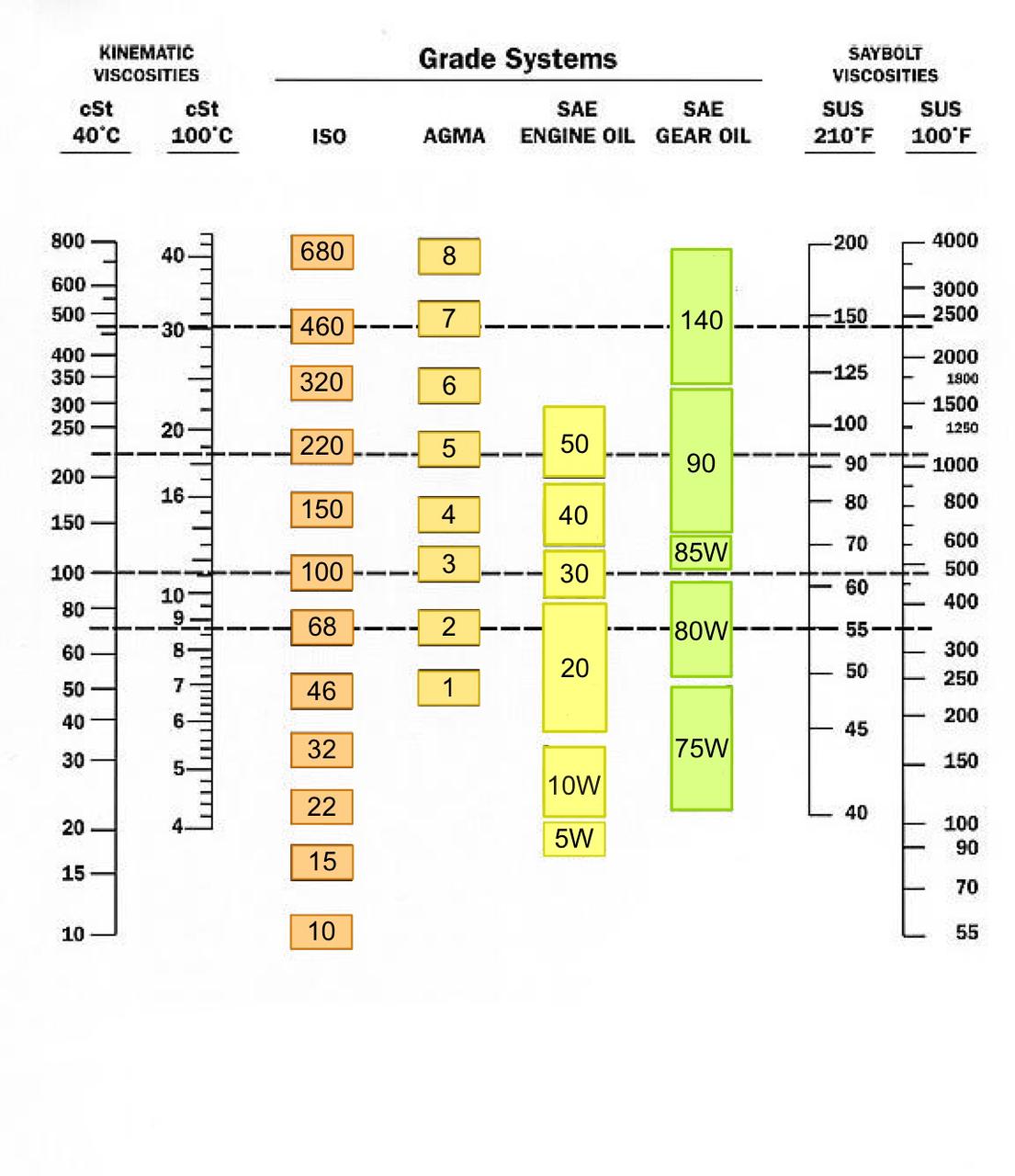
When oil lubrication is not suitable or cooling property is not needed for the application, we can offer a lubricating grease. Greases consist of a base oil thickened by a soap, to ensure the grease remains at the lubrication point. Greases also offer wear and friction protection and they provide a seal against external effects like moisture and contaminants.
Common applications for greases are: rolling bearings, friction bearings, spindles, seals, guides, chains and gears.
The characteristics and standards that need to be considered to choose a grease are:
Characteristics |
Standard |
Description |
Viscosity of the Base Oil |
ASTM D445 |
Will determine speed range and load capacity. |
Dropping Point |
ASTM D2265 |
Maximum temperature at which the grease will retain its structure and pass to liquid state. |
Operating Temperature |
ASTM 2595 ASTM D1478 |
Range for optimal function. |
Speed |
|
Maximum rotating speed when used in a roller bearing. |
Penetration |
ASTM D217 |
Work or Unworked. To determine consistency of the grease. |
NLGI Grade |
ASTM D217 |
Determines the consistency class. |
Four-Ball Test |
ASTM D2596 ASTM D2266 |
Determines wear resistance and extreme pressure (EP) characteristics. |
Characteristics |
Standard |
Description |
Viscosity of the Base Oil |
ASTM D445 |
Will determine speed range and load capacity. |
Dropping Point |
ASTM D2265 |
Maximum temperature at which the grease will retain its structure and pass to liquid state. |
Operating Temperature |
ASTM 2595 ASTM D1478 |
Range for optimal function. |
Speed |
|
Maximum rotating speed when used in a roller bearing. |
Penetration |
ASTM D217 |
Work or Unworked. To determine consistency of the grease. |
NLGI Grade |
ASTM D217 |
Determines the consistency class. |
Four-Ball Test |
ASTM D2596 ASTM D2266 |
Determines wear resistance and extreme pressure (EP) characteristics. |
We can identify three main components in Greases. First, the base which consists of a Base Oil (Mineral or Synthetic). Then, a soap or thickener which will determine the performance. In the third place, the additives that will improve the performance of the grease in many processes. Some examples of additives for greases are: EP Improvers, Oxidation Inhibitors, Wear Protection, Friction Improvers, Adhesion Improvers, Solid Lubricants and Detergent Dispersants.

The Soap will have influence on the characteristics and features of the Grease. Some examples of Soaps are: Calcium, Lithium, Aluminum Complex, Barium Complex, Calcium Complex, Lithium Complex, Bentonite (Clay) and Polycarbamide. Also, the base oil has to be considered as well to determine characteristics such as the Operating Temperature of the Grease.
Thickener (Soap) |
Operating Temperature (ºF) |
Dropping Point (ºF) |
Water Resistance |
Load Capacity |
|
Mineral Oil |
Synthetic Oil |
||||
Calcium |
-22 to + 122 |
N/A |
< 212 |
++ |
+ |
Lithium |
-31 to + 248 |
-76 to + 320 |
338 / 392 |
+ |
- |
Al – Complex |
-22 to + 284 |
-76 to + 320 |
> 446 |
+ |
- |
Ba – Complex |
-13 to + 284 |
-76 to + 320 |
> 428 |
++ |
++ |
Ca – Complex |
-22 to + 284 |
-76 to + 320 |
> 374 |
++ |
++ |
Li – Complex |
-40 to + 284 |
-76 to + 320 |
> 428 |
+ |
- |
Bentonite |
-40 to + 284 |
-76 to + 356 |
- |
+ |
- |
Polycarbamide |
-22 to + 320 |
-40 to + 320 |
482 |
+ |
- |
Compatibility between the base oils has to be considered as well as compatibility between the soaps in the Grease. This table is a basic guide and shows which soaps are Miscible (M):
|
Ca-Soap |
Cax-Soap |
Li-Soap |
Lix-Soap |
Li/Ca-Soap |
Na-Soap |
Bentonite |
Bax-Soap |
Alx-Soap |
Polycarbamide |
Ca-Soap |
M |
M |
M |
M |
M |
|
M |
M |
|
M |
Cax-Soap |
M |
M |
M |
M |
M |
|
M |
M |
|
M |
Li-Soap |
M |
M |
M |
M |
M |
|
M |
M |
|
M |
Lix-Soap |
M |
M |
M |
M |
M |
|
|
M |
M |
|
Li/Ca-Soap |
M |
M |
M |
M |
M |
|
M |
M |
|
M |
Na-Soap |
|
|
|
|
|
M |
M |
M |
|
M |
Bentonite |
M |
M |
M |
|
M |
M |
M |
M |
|
M |
Bax-Soap |
M |
M |
M |
M |
M |
M |
M |
M |
M |
M |
Alx-Soap |
|
|
|
M |
|
|
|
M |
M |
M |
Polycarbamide |
M |
M |
M |
|
M |
M |
M |
M |
M |
M |
Greases can be classified into NLGI categories according to DIN 51818 performing a Penetration Test (DIN ISO 2137). NLGI Grade determines the consistency of a grease. Softer and more fluid greases have lower NLGI Grades (000) while firmer greases will have higher NLGI Grades (6). Most standard greases are usually NLGI 2.
This table classifies greases into NLGI Grades and shows possible applications for each NLGI Grade:
NLGI |
Worked Penetration (mm/10) |
Gear Lubrication |
Friction Bearings |
Roller Bearings |
Water Pumps |
Block Greases |
000 |
445 – 475 |
✓ |
|
|
|
|
00 |
400 – 430 |
✓ |
|
|
|
|
0 |
355 – 385 |
✓ |
|
|
|
|
1 |
310 – 340 |
✓ |
✓ |
✓ |
|
|
2 |
265 – 295 |
|
✓ |
✓ |
|
|
3 |
220 – 250 |
|
✓ |
✓ |
|
|
4 |
175 – 205 |
|
|
✓ |
✓ |
|
5 |
130 – 160 |
|
|
|
✓ |
|
6 |
85 – 115 Unworked Penetration |
|
|
|
|
✓ |
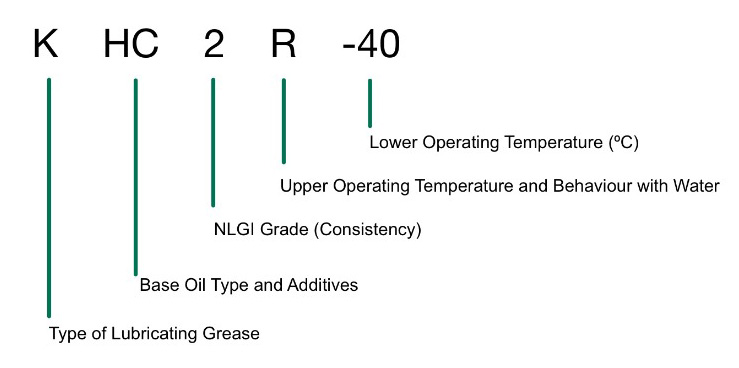
The first place will determine the Type of the Lubricating Grease:
Code |
Type of Lubricating Grease |
K |
Greases for roller bearings, friction bearings and sliding surfaces |
G |
Greases for closed gears |
OG |
Greases for open gears (adhesive lubricants without bitumen) |
M |
Greases for friction bearings and seals |
Second, the Base Oil Type is determined:
Code |
Base Oil Type |
E |
Ester Oils |
FK |
Fluorinated Hydrocarbons |
HC |
Synthetic Hydrocarbons |
PG |
Polyglycols |
PH |
Phosphoric Acid Ester |
Si |
Silicone Oils |
X |
Other |
Also, the presence of additives can be determined:
Code |
Additive |
P |
EP Additive |
F |
Solid Lubricants Added (like MoS2) |
The NLGI grade follows on the code, and finally in the last place, the Temperature Range for the grease can be found:
Code |
Upper Operating Temperature |
Behavior with Water (DIN 51807) Part 1* |
C |
+60ºC (140ºF) |
0 – 40 or 1 – 40 |
D |
2 – 40 or 3 – 40 |
|
E |
+80ºC (176ºF) |
0 – 40 or 1 – 40 |
F |
2 – 40 or 3 – 40 |
|
G |
+100ºC (212ºF) |
0 – 90 or 1 – 90 |
H |
2 – 90 or 3 – 90 |
|
K |
+120ºC (248ºF) |
0 – 90 or 1 – 90 |
M |
2 – 90 or 3 – 90 |
|
N |
+140ºC (284ºF) |
|
P |
|
|
R |
|
|
S |
|
|
T |
|
|
U |
|
T* 0 = no change
1 = minor change
2 = moderate change
3 = strong change
Anti-Seize Compounds can help to assemble and dismantle in an easier way. They have a similar structure to greases but with a higher amount of solid lubricants. They also have a Base Oil, a Solid Lubricant, Thickeners and Additives for improved properties.
Anti-Seize Compounds allows reliable lubricating, separating and corrosion protection, even when used under extreme pressure and temperature in aggressive conditions. Common applications include screwed connections, pins and bolts pressing and gearwheels.
Some key characteristics of Anti-Seize Compounds are:
Press Fit Test: Evaluates the lubricant effect of the Anti-Seize Compound at high pressure and low sliding speed.
Thread Friction Coefficient: According to ISO 16047, evaluates the friction coefficient of screws and nuts tightened on a test bench.
Breakaway Torque: According to ISO 10964, calculates the breakaway torque when loosening the screwed connection to the tightening torque.
Operating Temperature: Lubrication temperature has to be considered and will indicate when oil and solid lubricants are still effective. After the oil has evaporated, a separating effect will still exist through the solid lubricants.
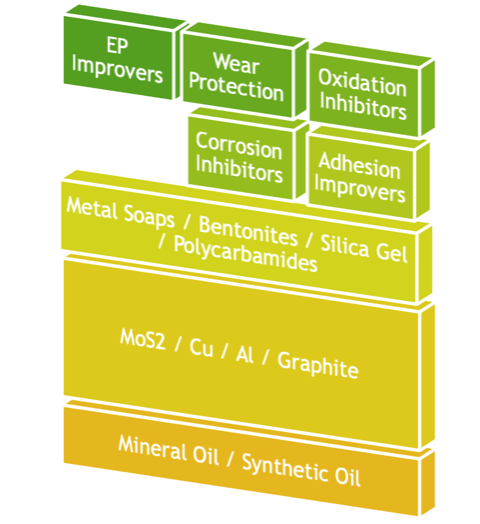
The solid lubricant present in the Anti-Seize Compound will have influence on the application, and in the operating temperatures of the compound, as the following table shows:
Solid Lubricant |
Maximum Operating Temperature (ºF) |
Field of Application |
PTFE |
< 572 |
Mounting |
MoS2 |
< 842 |
Mounting and press-on |
Aluminum |
< 2012 |
High temperature screwed connections |
Copper |
< 2012 |
High temperature screwed connections, Anti-Seize, electric conductivity |
Oxide Ceramics |
< 2552 |
Extreme temperature and stainless steel screwed connections. |
Solid lubricants are used as fine powder and can be categorized by structure, and into chemically and physically active substances.
Common Solid Lubricants include MoS2, Graphite, Tri-calcium Phosphate, Calcium Hydroxide, Aluminum, Zinc Pyro-Phosphate, Zinc Sulphide, Zinc Oxide, Calcium Fluoride, PTFE and PE.
MoS2 or Molybdenum Disulphide provides the best lubrication properties. The layer lattice structure and its chemically effective properties on the metals, allow low friction, wear protection and high pressure absorption. The layer is stable even with a thin film. The crystal structure of MOS2 has adhesive and sliding properties.
The high quality of our products is assured through Standard Testing procedures. Our products are developed and manufactured following rigorous Standards. A description of the most common Tests is provided below:
• Flash Point: Useful to asses danger of fire. There are multiple methods and standards, but most common are closed cup method (ASTM D56) and open cup method (ASTM D92).
• Thread Friction: According to ISO 16047, determines coefficient of friction when fasteners are tightened on a screw test bench.
• Condensed Water Test: According to ISO 6270-2 and performed in a climatic chamber to asses a protective layer against corrosion influence. The result shows the number of hours until rust shows up on the surface.
• Penetration: ISO 2137 determines the consistency of a lubricating grease using a penetrometer. The penetration of a standardized cone is measured and NLGI is determined.
The lubricant can also be worked to imitate stress.
• Breakaway Torque: Ratio of loosening torque to tightening at a temperature between 392ºF and 1202ºF for 100 hours.
• Pour Point: According to ASTM D97 it is usually some degrees under the recommended lowest operating temperature.
• Press Fit Test: Used to test adhesion of solid lubricants under high pressure and low sliding speed, and measure coefficient of friction. These results have to be considered on mounting applications and also on slideways and guides.
• Salt Spray Test: According to ASTM B117 to simulate a salty environment on coated plates. It will determine the amount of time until rust arises.
• SKF – EMCOR Test: Test corrosion Preventive Properties under dynamic wet conditions, according to ASTM D6138. Running duration, speed and stop sequence are pre-determined. A rating from 0 to 5 is assigned to results, where 0 means no corrosion detected and 5 means severe corrosion was found.
• Dropping Point: According to ASTM D2265, determines the temperature of a grease at which it becomes liquid from a semi-solid state and is an indication of the heat resistance of the grease. It is over the recommended upper limit of the operating temperature.
• Four Ball Test: According to ASTM D2266 for lubricants used at high surface pressures. A rotating moving ball slides on three fixed balls. This test can provide information on the extreme pressure properties of a lubricant, and also to measure the performance regarding wear.
• Viscosity: Following ASTM D445 and using different instruments depending on the lubricant, such as a falling ball viscosimeter. Kinematic viscosity is tested at +40ºC and sometimes also +100ºC.